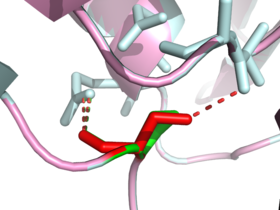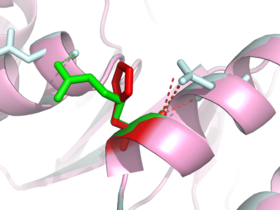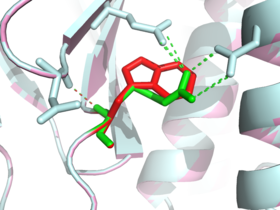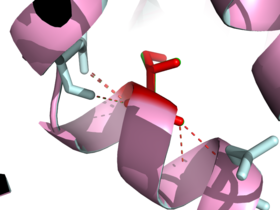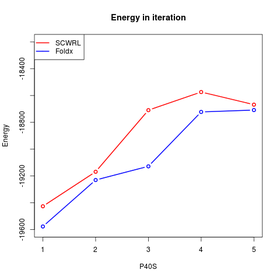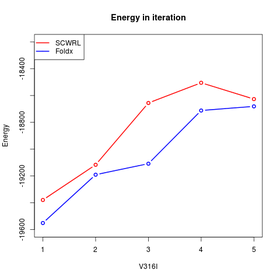Difference between revisions of "Fabry:Structure-based mutation analysis"
Rackersederj (talk | contribs) (→Minimise) |
Rackersederj (talk | contribs) (→References) |
||
| Line 620: | Line 620: | ||
=== Gromacs === |
=== Gromacs === |
||
| + | |||
| + | == Conclusion == |
||
| + | What are we concluding this week? Which one is disease causing? |
||
== References == |
== References == |
||
Revision as of 18:40, 23 June 2012
Fabry Disease » Structure-based mutation analysis
The following analyses were performed on the basis of the α-Galactosidase A sequence. Please consult the journal for the commands used to generate the results.
Contents
Preparation
<figtable id="tab:Prep">
All available PDB structures assigned to the Uniprot entry P06280 along with the according Resolution,
Coverage and R-factor. The R-factor was obtained from the PDBsum page. The chosen structure 3S5Y is highlighted.
| Entry | Method | Resolution (Å) | Chain | Positions (up to 429) | R-factor<ref>R value http://www.proteopedia.org/wiki/index.php?title=R_value&oldid=569063, last checked on June 21, 2012</ref> | R-free<ref>Free R http://www.proteopedia.org/wiki/index.php?title=Free_R&oldid=1390871, last checked on June 21, 2012</ref> | pH | PDBsum | PDB |
|---|---|---|---|---|---|---|---|---|---|
| 1R46 | X-ray | 3.25 | A/B | 32-422 | 0.262 | 0.301 | 8.0 | [»] | [»] |
| 1R47 | X-ray | 3.45 | A/B | 32-422 | 0.285 | 0.321 | 8.0 | [»] | [»] |
| 3GXN | X-ray | 3.01 | A/B | 32-421 | 0.239 | 0.301 | 4.5 | [»] | [»] |
| 3GXP | X-ray | 2.20 | A/B | 32-422 | 0.204 | 0.265 | 4.5 | [»] | [»] |
| 3GXT | X-ray | 2.70 | A/B | 32-422 | 0.245 | 0.306 | 4.5 | [»] | [»] |
| 3HG2 | X-ray | 2.30 | A/B | 32-422 | 0.178 | 0.202 | 4.6 | [»] | [»] |
| 3HG3 | X-ray | 1.90 | A/B | 32-426 | 0.167 | 0.197 | 6.5 | [»] | [»] |
| 3HG4 | X-ray | 2.30 | A/B | 32-423 | 0.166 | 0.221 | 4.6 | [»] | [»] |
| 3HG5 | X-ray | 2.30 | A/B | 32-422 | 0.192 | 0.227 | 4.6 | [»] | [»] |
| 3LX9 | X-ray | 2.04 | A/B | 32-422 | 0.178 | 0.218 | 6.5 | [»] | [»] |
| 3LXA | X-ray | 3.04 | A/B | 32-426 | 0.216 | 0.244 | 6.5 | [»] | [»] |
| 3LXB | X-ray | 2.85 | A/B | 32-427 | 0.227 | 0.264 | 6.5 | [»] | [»] |
| 3LXC | X-ray | 2.35 | A/B | 32-422 | 0.186 | 0.237 | 6.5 | [»] | [»] |
| 3S5Y | X-ray | 2.10 | A/B | 32-422 | 0.195 | 0.230 | 5.1 | [»] | [»] |
| 3S5Z | X-ray | 2.00 | A/B | 32-421 | 0.211 | 0.234 | 5.1 | [»] | [»] |
| 3TV8 | X-ray | 2.64 | A/B | 32-422 | 0.203 | 0.239 | 4.6 | [»] | [»] |
</figtable>
We did not choose the structure 3HG3, although it has the best resolution (1.90 Å) and the second best R-factor (see <xr id="tab:Prep"/>), which is a measure of the agreement between the crystallographic model and the experimental X-ray diffraction data <ref>R-factor (crystallography) (May 17, 2012) http://en.wikipedia.org/wiki/R-factor_%28crystallography%29, June 20, 2012</ref>, since it has an Alanin at position 170 (part of the active site) instead of an Aspartic acid. After excluding those structures, that had deviations in the sequence, we had to choose between ten sequences (1R46, 1R47, 3GXN, 3GXP, 3GXT, 3HG2, 3HG4, 3HG5, 3S5Y, 3S5Z) and decided to use 3S5Y. This structure has the advantage of a good pH, very good coverage and still reasonable resolution and R-factor.
Vizualisation
<figure id="fig:allSNPs">

</figure>
From the first glance, we would consider A143T as disease causing, because it is located right next to a Cysteine, that forms a disulfide bond (yellow) and might interfere with it. The same applies for S65T, which is in the structural neighborhood of this bond and also might cause atom clashes.
There is no mutation that can interfere with the active site(purple) or the substrate binding site (cyan).
The mutation N215S seems to play an important role in the binding of the ligand N-Acetyl-D-Glucosamine.
Both prolines Pro 323 and Pro 40 do not give the impression as if they would be very important. Also Arg 356 is on the surface of the protein and is not involved in any binding, although it might be influencing the nearby helix. This also is applicable for the SNP R118H.
It seems possible, that the mutation V316I does not have a big impact on the helix it is located in.
Neither Q279E nor I289V have an obvious reason to be considered as crucial in this structure.
Create mutation
Pymol
<figtable id="tab:Pymol"> Mutagenesis of the 10 selected SNPs performed with pymol. This was done on the basis of a backbone independant library. Usually the rotamer with the least atomic clashes was chosen. Clashes are depicted as red and green disks. The wildtype amino acid is shown in green, the mutated one in red. Hydrogen bonds of the mutant to the surrounding are depicted in blue. If shown, the active site (residues 170 and 231) is colored pink, substrate binding site (position 203-207) cyan and the existing five disulfide bonds (52 ↔ 94, 56 ↔ 63, 142 ↔ 172, 202 ↔ 223, 378 ↔ 382) are highlighted in yellow. Ligand atoms are represented as spheres in dark cyan.
</figtable>
Taking a closer look at each of the mutations, which are shown in the pictures in <xr id="tab:Pymol"/> we can underline most of our assumptions posed in section Vizualisation. The SNPs shown there were created with Pymol, a backbone independant library was used and we tried to pick that rotamer, that seemed to produce the least atom clashes. Inspite of that, A143T interferes with the ligand and a cysteine, that forms a disulfide bond and thus can be considered as an important site.
In this view, the mutation S65T does not seem to be that malign, since most of the important hydrogen bonds are kept and only little clashes are caused. The same applies again for V316I, Q279E and I289V. The most atom clashes are produced by the introduced Glu at position 279, but in all three point mutations the important h-bonds that stabilize the alpha-helix are still present.
The assumption that Asn 215 has an important role in binding of the ligand can be confirmed, but considering the newly introduced hydrogen bonds when mutating it to a Serine, that form a contact to N-Acetyl-D-Glucosamine the mutation might though be not disease causing. Again, both mutations of the prolines (P40S and P323T) seem to be not malign, since there appear hardly any atom clashes and all hydrogen bonds are still present.
The closer look at the SNP R118H reveals that this mutation has to be disease causing, since on the one hand the size and shape of the amino acid is changed completely and on the other hand the formed non covalent connections to the adjoint alpha-helices are changed completely. This conclusion can be drawn for the mutation of Arginine 356 to Tryptophane, because the crucial bonds to the alpha helix on the right are destroyed by the introduced aromatic rings.
SCWRL
<figtable id="tab:MutSCWRL"> Mutagenesis of the 10 selected SNPs performed with SCWRL. This was done on the basis of a backbone dependant library. The wildtype amino acid is shown in green, the mutated one in red. The whole structure of the wildtype is colored light blue, the mutant light red. Hydrogen bonds of the mutant to the surrounding are depicted in red, those of the not mutated site in green.
</figtable>
<figtable id="tab:EnergySCWRL">
Minimal energy introduced by the mutated site.
Shown is the energy if only chain A is mutated, as well
as the energy when both sites are mutated.
| SNP | Minimal energy Chain A |
Minimal energy Both chains |
|---|---|---|
| A143T | 142.857 | 290.65 |
| I289V | 138.101 | 277.376 |
| N215S | 143.36 | 287.975 |
| P323T | 143.375 | 287.394 |
| P40S | 144.203 | 289.775 |
| Q279E | 143.082 | 286.738 |
| R118H | 142.636 | 285.207 |
| R356W | 149.729 | 305.003 |
| S65T | 145.551 | 293.644 |
| V316I | 148.135 | 294.203 |
</figtable>
The mutations created by SCWRL are shown in <xr id="tab:MutSCWRL"/>(only chain A was mutated in the structures shown in these pictures), where they are also compared to the wildtype of this residue. Here the focus is on the newly introduced and the deleted hydrogen bonds. The amount of new connections correlates with the size of the minimal energy shown in <xr id="tab:EnergySCWRL"/>, the higher the number, the more new non-covalent bondings are formed and the more severe the changes are. The smallest value is a free energy of 138.101, which is obtained by the SNP I289V. Looking at the corresponding picture, we see that none of the h-bonds formed by the wildtype is changed by the mutant. The biggest value can be observed when examining the mutation R356W, where all hydrogen bonds on the right hand side are deleted due to the aromatic rings of the Tryptophane. The smallest values for single mutation sites are I289V, R118H and A143T.
Comparing the values of the structures where only one chain was mutated to these where both chains were mutated, a doubling of the values can be observed, but in most cases, the latter is roughly twice as big as the first term, but usually a little bigger.
Comparison energies
foldX
<figtable id="tab:energyStart"> ADD CAPTION HERE
| Type | Energy |
|---|---|
| BackHbond | -528.41 |
| SideHbond | -149.96 |
| Energy_VdW | -1013.85 |
| Electro | -25.51 |
| Energy_SolvP | 1310.89 |
| Energy_SolvH | -1318.53 |
| Energy_vdwclash | 99.21 |
| energy_torsion | 26.73 |
| backbone_vdwclash | 478.11 |
| Entropy_sidec | 482.20 |
| Entropy_mainc | 1219.31 |
| water bonds | -29.53 |
| helix dipole | -12.51 |
| loop_entropy | 0.00 |
| cis_bond | 4.50 |
| disulfide | -29.93 |
| kn electrostatic | -0.98 |
| partial covalent interactions | 0.00 |
| Energy_Ionisation | 1.20 |
| Entropy Complex | 0.00 |
| Total | 34.82 |
</figtable>
Minimise
<figure id="fig:Minimise1">
</figure> <figure id="fig:Minimise2">
</figure>
<figtable id="tab:Energies"> Comparison of the energies calculated by minimise after each iteration step. Each figure shows the energies of the structures created by SCWRL and FoldX for one point mutation. The SCWRL energies are plotted in red, FoldX energies in blue. It can be seen in all pictures, that the energies become worse (bigger) in almost each step and always are worse than at the beginning.
</figtable>
<figtable id="tab:MinItSCWRL"> Listed are the end energies calculated by minimise after each of the five iterations that were performed. Here the ten structures created by SCWRL are examined. The changes in energy are shown graphically in <xr id="tab:Energies"/>
| SNP | SCWRL It1 | SCWRL It2 | SCWRL It3 | SCWRL It4 | SCWRL It5 |
|---|---|---|---|---|---|
| A143T | -19350.019312 | -19086.904944 | -18612.004125 | -18465.456994 | -18604.774815 |
| I289V | -19366.341836 | -19106.551703 | -18632.845563 | -18472.982406 | -18599.386068 |
| N215S | -19376.824823 | -19108.432316 | -18643.149199 | -18492.843077 | -18605.553440 |
| P323T | -19411.264840 | -19148.605582 | -18673.449640 | -18534.560820 | -18672.199315 |
| P40S | -19425.839848 | -19168.356042 | -18708.851800 | -18573.675085 | -18667.681188 |
| Q279E | -19139.738142 | -18888.319266 | -18435.718753 | -18269.158013 | -18411.647623 |
| R118H | -19378.220189 | -19061.014555 | -19150.848580 | -18705.456218 | -18537.502227 |
| R356W | -19246.169328 | -18973.967986 | -18503.395130 | -18354.758680 | -18395.730581 |
| S65T | -19352.888992 | -19097.278927 | -18622.231727 | -18466.775427 | -18597.196520 |
| V316I | -19378.784400 | -19116.270827 | -18655.326214 | -18504.630300 | -18626.254331 |
</figtable>
<figtable id="tab:MinItFoldX"> Listed are the end energies calculated by minimise after each of the five iterations that were performed. Here the ten structures created by FoldX are examined. The changes in energy are shown graphically in <xr id="tab:Energies"/>
| SNP | foldX It1 | foldX It2 | foldX It3 | foldX It4 | foldX It5 |
|---|---|---|---|---|---|
| 10 | -19550.473733 | -19190.314305 | -19108.157691 | -18711.504604 | -18680.553293 |
| 1 | -19531.029798 | -19183.692071 | -19089.255299 | -18690.723619 | -18634.371787 |
| 2 | -19537.959020 | -19182.406085 | -19088.330009 | -18705.216460 | -18658.081500 |
| 3 | -19553.220266 | -19200.887512 | -19107.987222 | -18711.451446 | -18689.088254 |
| 4 | -19576.380756 | -19229.958904 | -19127.742078 | -18722.067291 | -18708.061808 |
| 5 | -19561.423303 | -19198.136649 | -19114.694341 | -18706.421023 | -18689.504411 |
| 6 | -19452.866584 | -19081.137040 | -18996.698705 | -18592.060634 | -18576.332278 |
| 7 | -19560.474624 | -19198.616169 | -19122.262254 | -18696.696700 | -18685.805709 |
| 8 | -19520.334103 | -19140.453395 | -19050.367498 | -18640.442363 | -18606.342629 |
| 9 | -19548.207104 | -19189.549676 | -19114.216039 | -18721.317687 | -18697.326878 |
</figtable>
Minimise tries to ??....??. In <xr id="fig:Minimise2"/> an example for a point mutation is shown. Here only little changes were performed by minimise. This might be due to the fact that this position has already been optimized by SCWRL (in this case). Other parts of the structure on the other hand, have been changed dramatically, which can be seen in <xr id="fig:Minimise1"/>. Another part of the same structure, where position 143 is mutated into a Threonine is shown. The two shown sheets were mutated into a coil during the fifth iteration of minimise. Similar modifications can be observed in the other SNP iterations, too.
In <xr id="tab:MinItFoldX"/> and <xr id="tab:MinItSCWRL"/> the end energies of the iterations are listed. Those are also shown in the figures in <xr id="tab:Energies"/> and compared there. The SCWRL structures always have a higher and thus worse energy than the FoldX structures, although it seems, that after five iterations the energy of the structures of both programs tend to become equal. (TODO: Maybe on example with more than 5 iterations. P232T?) What becomes obvious is, that minimise does not try to optimize the energy of the structure, because it gets worse in almost each iteration step.
(TODO: Move tables to own page)
Gromacs
Conclusion
What are we concluding this week? Which one is disease causing?
References
<references />













